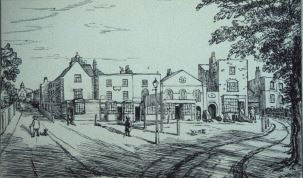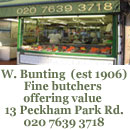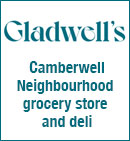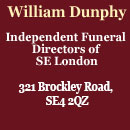A Timeline History of Camberwell
A timeline history of Camberwell with prints, photographs and maps
Click on images to enlarge



|
|---|
Originally Camberwell was a small village in the county of Surrey.
Medieval Camberwell
1086 Domesday Book mention of Ca'brewelle and St Giles Saxon church
1152 St Giles church rebuilt in stone
1279 Camberwell Fair first held in August for the Feast of St Giles, patron saint of Camberwell.
Stuart Camberwell
1615 Wilson's school founded by Edward Wilson, vicar of Camberwell.

1665 Great Plague - over 100 residents died
1674 Parishioners formed vestry (a local council)
Georgian Camberwell
1717 Champion Lodge built on corner of Love Walk and Denmark Hill for Champion de Crespigny family with 30 acres of parkland. The boundary wall remains on Love Walk.

1739 Map of Friern Manor (British
Museum) showed Camberwell Green
1745 John Rocque's map of Camberwell showed:
Rainbow lane (now Southampton Way)
Lamastee Lane (now Wyndham Road)
Walnut Tree Grove (now Camberwell Grove)
1748 Camberwell Hall opened on Grove Lane as the assembly room for the Camberwell Tea Gardens, which included extensive gardens. Became a popular venue for balls and concerts for the middle classes.
1769 Blackfriars bridge opened. It linked Camberwell to the City and led to much new building.
1775 View of Walnut Grove (now Camberwell Grove) with Camberwell Hall to the left and Old St Giles.

1779 Dr Lettsom (1744-1815) bought land on Grove Hill and had a villa there. It was accessed by Walnut Grove.
1782 Tollgate set up near Walworth Common (Westmoreland Rd)
1786 Old St Giles church expanded

1789 Plan of Camberwell Green showed Camberwell Green farm
facing Green
1790 Queen Lane (now lower part of Grove Lane)
1791 Map of Friern Manor
No 23 Champion Hill built by Michael
Searles
Regency Camberwell
1801 Census for parish of Camberwell - 7,059
Print of the Camberwell Fair.

1809 Grand Surrey Canal ran from River Thames at Rotherhithe to Camberwell Road.
1812 Robert Browning born in Rainbow Cottage, Cottage Green,
off Wells Way
1818 Camberwell New Road developed
Beresford Street Chapel built (now ruined)
Print of Dr Lettsom’s Grove Hill house

The Camberwell Workhouse opened in Havil Street in the parish of St Giles.
1819 Grove Chapel by David Roper opened on Camberwell Grove
1823 Failed attempt by Camberwell Vestry to close down Camberwell Fair.
John Ruskin (1819-1900) moved to 28 Herne Hill, aged 4.
1824 St George's Church, Wells Way by Francis Burford (1784–1858) It was built in the Greek Revival style.

1825 Denmark Place Baptist Church built
Tiger pub opened on Camberwell Green
1826 Beresford Street Chapel built on the south side of Beresford Street (now John Ruskin Street).
1827 First Vestry building, Havil St
1833 View of the Triangle at corner of Denmark Hill and Loughborough Junction.
Early Victorian Camberwell
1837 Cary’s map of London
1840s Champion Lodge demolished and Champion Hill developed
1840 Allport's History of Camberwell
1841 Census for parish of Camberwell - 39,868
Old St Giles Church burned down
1842 Spring Song (originally Camberwell Green) composed by Felix Mendelssohn (1809-1847).
Oct: John Ruskin moved to 163 Denmark Hill from Herne Hil
1844 New St Giles Church opened on Camberwell Church Street. Designed by George Gilbert Scott (1839-1897). It was built in in the Gothic Revival style with a 210 feet spire.

1846 Camberwell House Asylum opened on Peckham Road (now Sceaux Gardens
Estate).
1848 St Matthews Church built on Denmark Hill. (Partly destroyed in 1940).

Horse-drawn bus service introduced by Thomas Tilling (1825-1993). It ran 4 times a a day from Peckham to Oxford Street.

1853 Congregational Church (Camberwell Green Chapel) built on Wren Road on site of the Old House on the Green.
1855 Camberwell Fair (on Camberwell Green) suppressed due to “immoral and riotous behaviour”.
1857 Camberwell Vestry purchased Camberwell Green
1859 Camberwell Green opened as a public park
The Folklorist and song collector Cecil Sharp (1859 – 1924) born on Denmark Hill.
Mid Victorian London
1861 Census for parish of Camberwell - 71,488
Old Bowyer Manor House demolished (near Castlemead)
1862 Camberwell New Rd station (Station Rd) opened (closed 1916)
Camberwell Gate station (John Ruskin St) opened (closed 1916)
1863 Royal Flora Gardens closed (Wyndham Rd)
1866 Denmark Hill station opened. Designed by Charles Henry Driver (1832-1900).
1870 Saint James the Apostle opened on Knatchbull Road. Designed by T. George Low in a in a Decorated Gothic style, using Kentish ragstone and Bath stone.1871 John Ruskin sold 163 Denmark Hill (demolished in 1949 and replaced by Cross Court).
Ruskin moved to Brantwood House, Conistan in the Lake District.
1873 New Vestry Hall, Peckham Road
1875 Blanche's history of Camberwell published. Written at 55 Denman Rd.
St Giles Infirmary opened to north of the Camberwell Workhouse.
1877 Mary Datchelor's School opened on Camberwell Grove. Closed in 1981. St Marys Catholic Apostolic Church by J. & J. Belcher opened on Camberwell New Road.
Late Victorian London
1887 William Rossiter (1831-1897) opened his Free Library and Art Gallery at 207 Camberwell Road (later to move to Peckham Road as the South London Gallery).
1889 Cambridge House mission established.
Myatts Fields opened as a public park. Designed by Fanny Rollo Wilkinson (1855-1951), Britain's first professional woman landscape gardener.
1890 Circular ward block added to St Giles Infirmary. Each level contained 24 beds around a central shaft in which were the ventilation & heating services.

1891 Census for parish of Camberwell - 235,344
Clarendon Baptist Church opened on Councillor Street, off Camberwell New Road (now Cavalry Temple Church).
William Rossiter established the South London Gallery at Portland House on Peckham Road.
1892 Camberwell Public Baths opened with two large swimming pool halls, one behind the other.
1894 Metropole opened as a theatre & playhouse on the Triangle (corner of Coldharbour Lane & Denmark Hill).
1896 Oriental Palace of Varieties opened on the corner of Denmark Hill/Orpheus Street by Dan Leno (1860-1904).
Fred Karno (1866–1941) established his Fun Factory at 38 Southwell Road off Coldharbour Lane. It was home to his vaudeville theatre group which later included Charlie Chaplin and Stan Laurel.
1898 Technical Institute (later Camberwell School of Arts & Crafts) opened on the Peckham Road. Designed byMaurice Bingham Adams (1849–1933). It offered day and evening instruction across a wide range of subjects from Architecture, Furniture Design, Life Drawing and Stained Glass Work to Dressmaking. Fine arts department added in 1920.
Camberwell Police station opened on Camberwell Church Street.
1899 National Westminster Bank, 17Camberwell Green built (now surgery)
Oriental Palace of Varieties rebuilt as Camberwell Palace (2000 seater)
Edwardian Camberwell
1900 Borough of Camberwell established
Colour-tinted postcard of Camberwell Green

1901 Census for parish of Camberwell - 259,339
1903 Passmore Edwards Library, Baths and Wash House opened on the corner of Wells Way and Neate Street. Designed byMaurice Bingham Adams and William Oxtoby (1862–1918), on land donated by the Rolls family.

Hermit's Cave public house opened on Camberwell Church Street.
1905 Lyndhurst Junior School opened on Grove Lane.
1906 Bridge built over the Grand Surrey Canal (now in Burgess Park).
1907 Ruskin Park established on Denmark Hill
Brunswick Park opened (previously a private square).
1909 New Grand Hall opened at 315-317 Camberwell New Road (seated 814)
1910 Camberwell Green Peabody Trust flats built
1912 Cinematography Theater, Cam New Rd, opened
1913 Kings College Hospital built by WA Pite
Camberwell in WW1
1914 Golden Domes Picture Theatre opened at 28-32 Denmark Hill
(later Rex Cinema & Essaldo Cinema and now a supermarket)
Bijou Theatre opened at 37 Denmark Hill (later Denmark Hill Post Office)
1914 Picture Empire opened at 55 Camberwell Road

1915 Maudsley Hospital built
Lionel Morrekton’s Chalk Farm to Camberwell Green by Gertie Millar
1916 Camberwell New Rd and Camberwell Gate stations closed
1917 Zeppelin air raid on Calmington Road (now in Burgess Park) killed 12 people.

Prewar Camberwell
1919 War memorial unveiled at St George’s Church, Wells Way. Sculpture by Arild Rosenkrantz (1870-1964)
1920 Camberwell War memorial unveiled at Camberwell Cemetery, Forest Hill Road, SE22

1921 View of Denmark Hill with Camberwell Palace on left and Camberwell Empire at top
1927 Grove House Tavern rebuilt
1932 William Booth Memorial Training College opened for the Salvation Army. Designed by Giles Gilbert Scott (1880-1960).
1933 Family of Michael Caine (born Maurice Micklewhite) moved to a two-room top floor flat (with outside toilet) at 14 Urlwin Street, SE5. Later attended John Ruskin School.
1934 Camberwell Town Hall opened. Designed by Culpin and Bowers
1939 Camberwell Empire demolished.
1939 Camberwell Odeon cinema built on the site of the Camberwell Empire. By Andrew Mather & Keith P. Roberts with seating for 2,470.
WW2 Camberwell
1940 Camberwell bombed during Blitz.
Regal Cinema opened at 254-272 Camberwell Road (bombed same year)
1943 County of London plan by Patrick Abercrombie published. Slum clearances and new open spaces including a North Camberwell space (Burgess Park).
1944 Camberwell suffered loss of life and damage to property from Flying Bombs
Post War Camberwell
1954 Champion Park estate opened (on site of Ruskin's house)
1958 Brandon estate built by the London County Council to designs by Edward Ernest Hollamby (1921-1999) and Roger Westman (1939-2020).

1959 Clarendon Baptist Church became Cavalry Church.
Sceaux Gardens Estate opened. An early example of high rise building.
1960 Camberwell School of Arts extension built
1961 Victorian Suburb: A Study of the Growth of Camberwell by HJ Dyos published.
St Giles Trust founded by Fr. John Nicholls as The Camberwell Samaritans in the crypt of the church, offering relief and support to the large number of destitute people in the parish.
Regal Cinema, Camberwell Road, renamed ABC.

1962 Two Piece Reclining Figure No. 3 (1961) sculpture by Henry Moore (1898-1986) acquired for the Brandon Estate.
1963 St Marys Catholic Apostolic Church became a Greek Orthodox Church.
The Changing Face of Camberwell Film (32:12 mins)
(high-rise buildings, parks, schools, churches, pubs & canal at 29:54)
1964 Wyndham Estate built
Syd Barrett (later of Pink Floyd) attended Camberwell Art School
1965 Kings College Dental hospital opened
Camberwell Borough became part of expanded Southwark Council
1967 St Giles Vicarage demolished to make way for St Giles Centre
Pink Floyd first official photo session was in Ruskin Park

1968 Kings College Extension high rise block opened
Grand Cinema (ex-New Grand Hall) closed (later Bingo Hall & Snooker Hall & demolished in 2014)
1970 Grand Surrey canal closed.
Camberwell Society formed.
1971 Magistrates Court, Camberwell Green, opened
1972 Castlemead Estate by GLC Architects opened on Camberwell Road.
St George’s Church closed on Wells Way. Later converted to housing.
1973 ABC Cinema closed. Became a Bingo Hall and later a church.
1974 Burgess Park named after Councillor Jessie Burgess who had been Mayoress of Camberwell. It is built over slum clearance and the old Grand Surrey Canal.
1975 Wilson’s School moved to Croydon.
Odeon Camberwell on Denmark Hill closed.
1982 Selbourne Estate built by Wates.
A large lake was added toBurgess Park. It had the world’s largest plastic sheet lining, 12 million gallons of water and 11,000 fish.

1984 Denmark Hill station rebuilt after 1980 fire
1986 House of Love founded. Based in Camberwell
1993 Odeon Camberwell demolished.
1995 Foyer homeless centre set up by Centrepoint on site of the Odeon.
Chumleigh Gardens in Burgess Park restored as World Gardens
2009 Mary Datchelor's school buildings covered to flats.
Southwark Town Hall on Peckham Road closed after Southwark Council moved to Tooley Street.
2012 Denmark Hill linked to new London Overground.
Burgess Park re-opened after an £8m redevelopment.
2013 Camberwell Police station closed.
2015 New Camberwell library opened by Camberwell Green
s.jpg)
2017 Demolition of Aylesbury Estate began
Further reading
Ye Parish of Camberwell - WH Blanch (1875)
Old Camberwell - Philip Mainwaring Johnston (1919)
Victorian Suburb: A Growth of Camberwell - HJ Dyos (Univ of Leicester 1961)
Story of Camberwell - Mary Boast (Southwark Libraries 1996 rev ed)
Battle of South London - Arthur B Woolf (1945?)




















